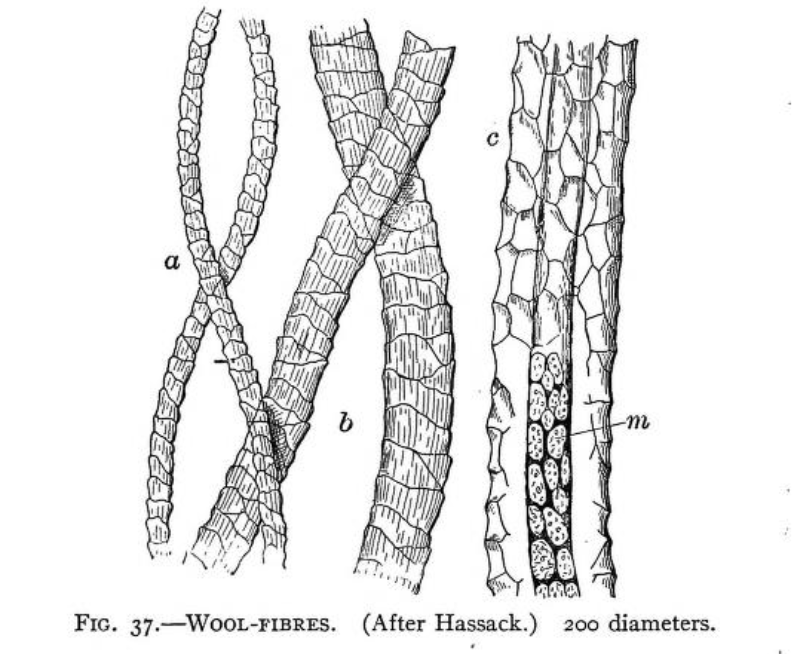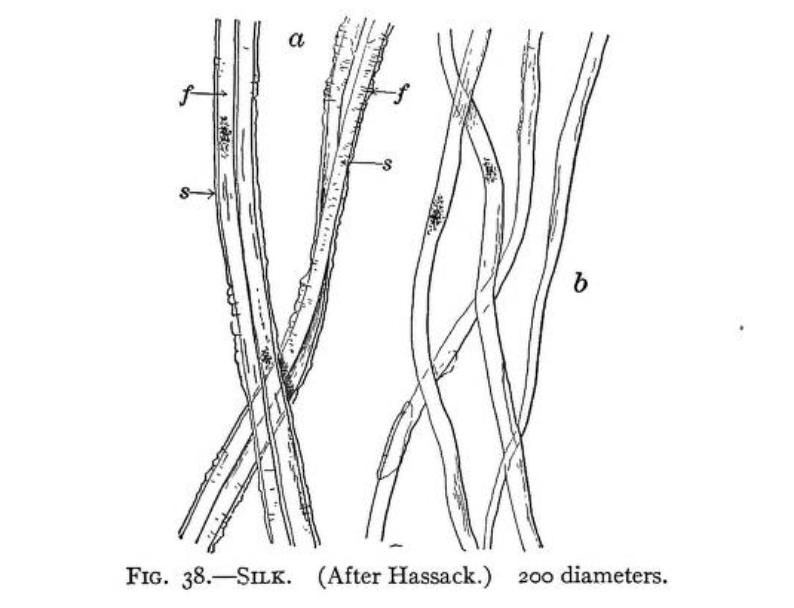Protein Fibers
Wool
Wool fiber is harvested from animals, such as sheep, goats and alpaca, and can be obtained in many different grades that make it softer, more brash, etc. for different purposes. When the word "wool" is used, it is typically referring to sheeps wool. Typically, wools with shorter and finer staple lengths (like cashmere or merino) are carded into woolen yarns for exceptional softness. Longer staple fibers are used for more durable applications. Wool is often noted for its unique "crimped" structure, elasticity, and durability (in the sense that you can bend the fibers lots and they don't break). The little crimps or barbs of the wool fiber, make it hold really nicely to other fibers when it is spun into yarn, also making it a bit more durable (as long as it isn't wet). Because of these crimps, wool fibers line up in yarn with little pockets of air between them. These little air pockets give it is insulating qualities and heat and cold can't easily move through the contained little air pockets. It is naturally fire resistant (to some degree). Additionally, the cellular makeup of wool makes it particularly good at "wicking" moisture and absorbing it.

Image Source: https://archive.org/details/cu31924031496833
"Wool fibers are made up of cortical cells, and these cells are wrapped in cuticle. This scaly outer layer is then covered by yet another layer, the epicuticle -- a filmy skin that helps to repel moisture. What's more, the epicuticle also helps out in high humidity because it has tiny pores that draw in the moisture vapor to the center of the fiber where it's absorbed by a chemical process. The hydrogen bond of water, H2O, is actually broken, creating a chemical reaction with the wool fiber molecules to generate heat when it has taken on a lot of moisture. But because the air pockets allow moisture to evaporate from your skin, you won't overheat when you sweat." [Source]

Image Source: https://commons.wikimedia.org/wiki/File:CSIRO_ScienceImage_2490_Schematic_for_Wool_Fibre.jpg
I have heard that wool can absorb 30% of its weight in water and still remain dry to the touch. This keeps the body cool and dry, and also allows wool to have natural anti-static properties, meaning it won't cling to your skin and, in terms of electronics, won't build up charge. The elasticity of wool means that it can hold its shape (or have "memory") better than other fibers, as long as it isn't wet.
Harvesting
Wool is harvested by sheering the animal to obtain the fleece, cleaning the fleece (to clean off the oils) and then processing into your desired structure.
- How Its Made Video: https://www.youtube.com/watch?v=FsRxMsBGuFs
- More processing Details from Woolmark: https://www.woolmark.com/about-wool/wool-processing/
Popular Varieties
- Merino Wool Super Soft and Springy https://www.smartwool.com/discover/what-is-merino-wool.html
- Alpaca Also very Soft and Fine https://www.peruvianconnection.com/category/fiber+and+product+information/alpaca+fiber.do
- Cashmere Taken from the downy undercoat of goats and made into super soft and warm products https://www.youtube.com/watch?v=wZ5q0TVD0aM
Sourcing
| Structure | Possibility to Source in this Structure |
|---|---|
| Fiber | Easy |
| Roving | Easy |
| Plied Yarn | Easy |
| Braided Rope | unsure |
| Filament | impossible |
| Knit | Easy |
| Woven | Easy |
| Non-Woven | Easy, Sold as Felt |
Silk
Silk is a protein fiber that is harvested from the cocoons of silk worms. There are many varieties of silk depending on the species, diet, etc. of the worm that spun the cocoon. The two main kinds of silk are "mulberry" and "tussah" silk. Mulberry silk comes from the domesticated species "bombyx mori” and is a bit finer and of higher quality as it comes from a very specific breed of worm whose diet consists only of mulberry leaves. Tussah silk comes from a variety of species who live wild largely in South Asia and has a denser and more fibrous structure.
The general structure of wool (the cross-section) is roughly triangular with curved corners. This allows it to reflect light well and gives it a really nice sheen. Mulberry silk is considered a natural filament, as a single cocoon can yield nearly

Harvesting
Mulberry Silk is harvested by boiling silk cocoons and unraveling the single strands as shown here. Tussah Silk involves a similar process, shown here.
Sourcing
| Structure | Possibility to Source in this Structure |
|---|---|
| Fiber | Easy |
| Roving | Easy |
| Plied Yarn | Easy |
| Braided Rope | unsure |
| Filament | because of its fineness and length, silk is considered a filament as well |
| Knit | Possible |
| Woven | Easy, Silk is most often woven |
| Non-Woven | Tussah silk roving can have a felt-like quality, the cocoon itself could be considered a non-woven and can be purchased online |